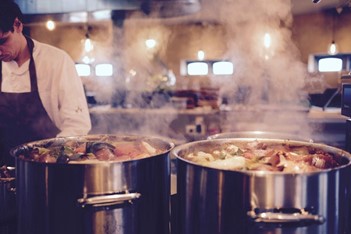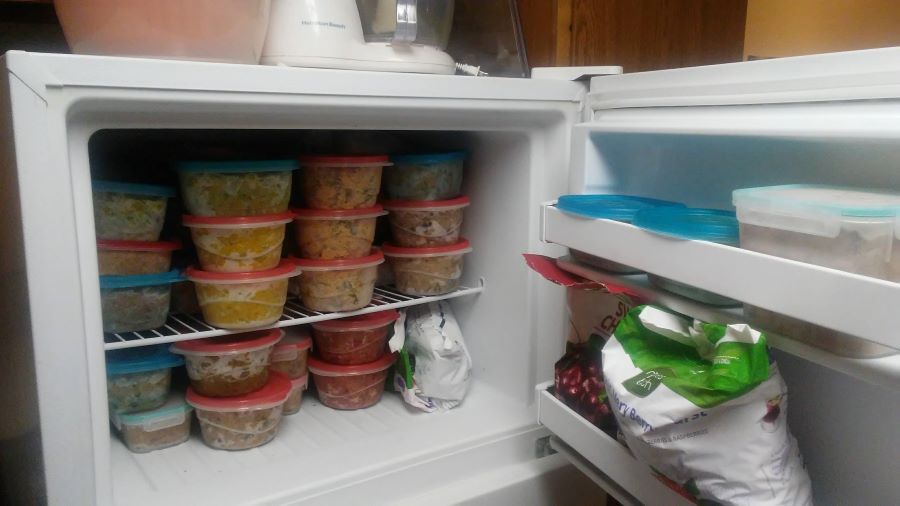
My partner and I don’t have the time or the energy to cook every night. Our solution is to cook in bulk – to make big batches of food that create an abundance of leftovers.
Bulk cooking is extremely efficient. It involves fewer trips to the grocery store and less time in the kitchen than daily cooking. It also reduces the likelihood of going out to eat, which is generally more expensive and less healthy.
And with our batch cooking, we’re committed to the following goals:
- The food should be delicious.
- The food should be healthy.
- And there should be a variety of flavors.
These requirements address many of the problems people have with big-batch cooking. Some don’t know how to cook healthy food that’s delicious. Many people fall into a rut when they go grocery shopping and greatly limit the variety of food they eat. And hardly anyone has an effective strategy for bulk cooking in such a way that they don’t get bored with what they’re eating.
For these reasons, I’ve decided to share our method for delicious batch cooking that maximizes both nutrition and flavor variety. We abide by the following six principles.
1. Make two pots.
The first principle of our batch cooking is to make two large pots of food – usually curry but sometimes soup or stew. Each pot is a different recipe that creates a very different flavor than the other. This means that we can rotate from one type of leftovers to the other, never eating the same thing two days in a row.
Here are a few examples of the two pots we might make in a bulk cook:
- Thai green curry and Rogan Josh curry
- Italian soup and African peanut soup
- Kenyan curry and Orange-ginger stew
Initially, I got recipes from the internet and from cookbooks, but eventually, I developed enough understanding of flavor combinations to invent my own dishes. Curries and soups are actually really easy. You can taste-test each pot when it’s nearly done and make adjustments as needed. If it doesn’t turn out amazingly, you can do it differently next time.
You really don’t need to be a master chef to make delicious food. For example, Italian soup is just olive oil, garlic, onion, Worcestershire sauce, powdered thyme, rosemary, and sage, soup stock, and whatever protein/veggies you want. It’s not complicated, but it is delicious.
2. Use the biggest pots possible.

The efficiency of bulk cooking is greatest when you’re making really big batches. If you’re going to spend several hours of labor – grocery shopping, cutting veggies, and cooking – you might as well go big. The only part of the labor that increases when you make a bigger batch is cutting veggies. The grocery shopping and the cooking labor are essentially the same regardless of how much you make.
So use the biggest pots possible and fill them to the brim. If you don’t own any large pots, make the investment. It’ll end up saving you time and money in the long run. (Currently, we’re using ten-quart pots, similar to these ones.)
In addition, we eat our curry/soup with quinoa (also prepared in large batches), which makes it last longer. Brown rice would also be a fine option.3.
3. Use a variety of veggies in each.
Another benefit of using really big pots is you can cram a larger variety of veggies into your dishes. I try to include one or more vegetables from each of the following categories in each pot:
- Roots (carrot, daikon, parsnip, etc.)
- Cruciferous (broccoli, cabbage, bok choy, etc.)
- Mushrooms (oyster, chanterelle, shitake, etc.)
- Nightshades (peppers, tomatoes, eggplant, etc.)
- Squashes (butternut, zucchini, yellow, etc.)
- Greens (kale, chard, collards, etc.)
- Herbs (cilantro, basil, green onion, etc.)
Hitting all or most of these categories in each pot ensures we’re getting a broad spectrum of nutrients with each serving. (An example is given below.)
Furthermore, I always strive to buy different veggies for each pot of food in order to increase nutritional variety. Since we’re rotating between the two dishes each day, we’re not eating the same veggies each day. If one of the batches is lacking in some area, the other will probably make up for it.
4. Rotate among many different vegetables.
In addition, I try to buy different veggies each time I shop for bulk cooking.
There are some staples veggies that get repeated often, either because they’re cheap, easy, or required by recipes. But as much as possible, I try to abide by the following rule: “If I bought it last time, I won’t buy it this time.”
5. Rotate among many different recipes.
We also rotate among over a dozen different recipes whenever we batch cook, and we never repeat the same recipes back-to-back. This helps increase the flavor variety and keeps things interesting. We have staples that we come back to again and again, but we also try new recipes on a regular basis and experiment with adjustments to old classics.
6. Freeze 1/3 of the results.
Now, this is where our strategy really shines. Each time we bulk cook, we freeze about one-third of what we made. To do this, wait until the next day after everything has had time to cool in glass bowls in the fridge. Then, load your freezer with tupperwares that each contains one meal of food (size depending on the number of people included in the meal).
When we’re bulk cooking every other weekend, we build up a stock of freezer meals. Then, if we don’t have time to cook for a few weeks, we start pulling from the freezer. We pull a different type for each day (a day or two in advance so it can thaw), and we might find ourselves eating six different recipes in a single week. Thus, when we’re the most busy and tired, we’re actually eating the greatest variety of flavors and vegetables.

And let me tell you, there is something deeply satisfying about having a freezer full of ready-to-go homemade meals. For me, at least, it creates a comforting feeling of security because I know that I don’t have to worry about planning or preparing food for a while.
An example of delicious, nutritionally dense bulk cooking
To demonstrate the incredible volume and variety of flavors and ingredients that can go into two pots of food, let’s take an in-depth look at one of our cooking efforts from last fall.
The two recipes we made in our ten-quart stockpots were Lemongrass Curry and Pineapple Panang Curry, details below.
Lemongrass Curry:
- Coconut oil
- Garlic olive oil
- 1 large bunch of lemongrass, blended
- 6 Thai green chiles
- 1 jar mild Indian curry paste
- 3 tbsp asafetida (a substitute for onion)
- 3 tsp black pepper
- 3 tbsp cumin
- Juice of one lemon
- 2 boxes of soup stock
- 1 tbsp stevia
- 5 lbs. tempeh
- 2 lbs. carrots
- 1 medium purple cabbage
- A bunch of chanterelles
- 2 yellow squashes
- 4 bell peppers
- 2 bunches of red chard
- 1 bunch of green onions
Pineapple Panang Curry:
- Coconut oil
- 1 tbsp ground galangal
- 1 tbsp asafetida
- 2 tbsp ground coriander
- 8 tbsp Panang curry paste
- 30 oz. of coconut milk
- 4 tbsp fish sauce
- 5 lbs. tempeh
- 12 oz butternut squash
- 1 large daikon radish
- A bunch of shitake mushrooms
- 1 small green cabbage
- 5 poblano peppers
- 2 large fennel bulbs
- 3 cans of pineapple chunks w/ juice
- 2 bunches of purple kale
- 2 packs of lime leaves
- 3 packs of basil
Here they are, nearly finished:

At this stage, the pots were almost completely full, but the greens (chard, kale, and basil) had not yet been added. The total volume of vegetables remaining was roughly equal to a single pot’s ten-quart volume, but greens like these can be packed into even the fullest of pots. They don’t add to the volume; they just add to the nutritional density.
Yes, our method is weird.
If all this seems crazy to you, remember that being a health nut isn’t actually crazy at all – eating the typical American diet is.
And to us, spending time and energy each day planning and cooking a new meal is unsustainable. It makes far more sense for us to cook in bulk.
If you’re already a big-batch cooker, awesome. I hope the ideas here will enhance your system. And if you’ve never done it, give bulk cooking a try. You might be surprised how much you like it.
